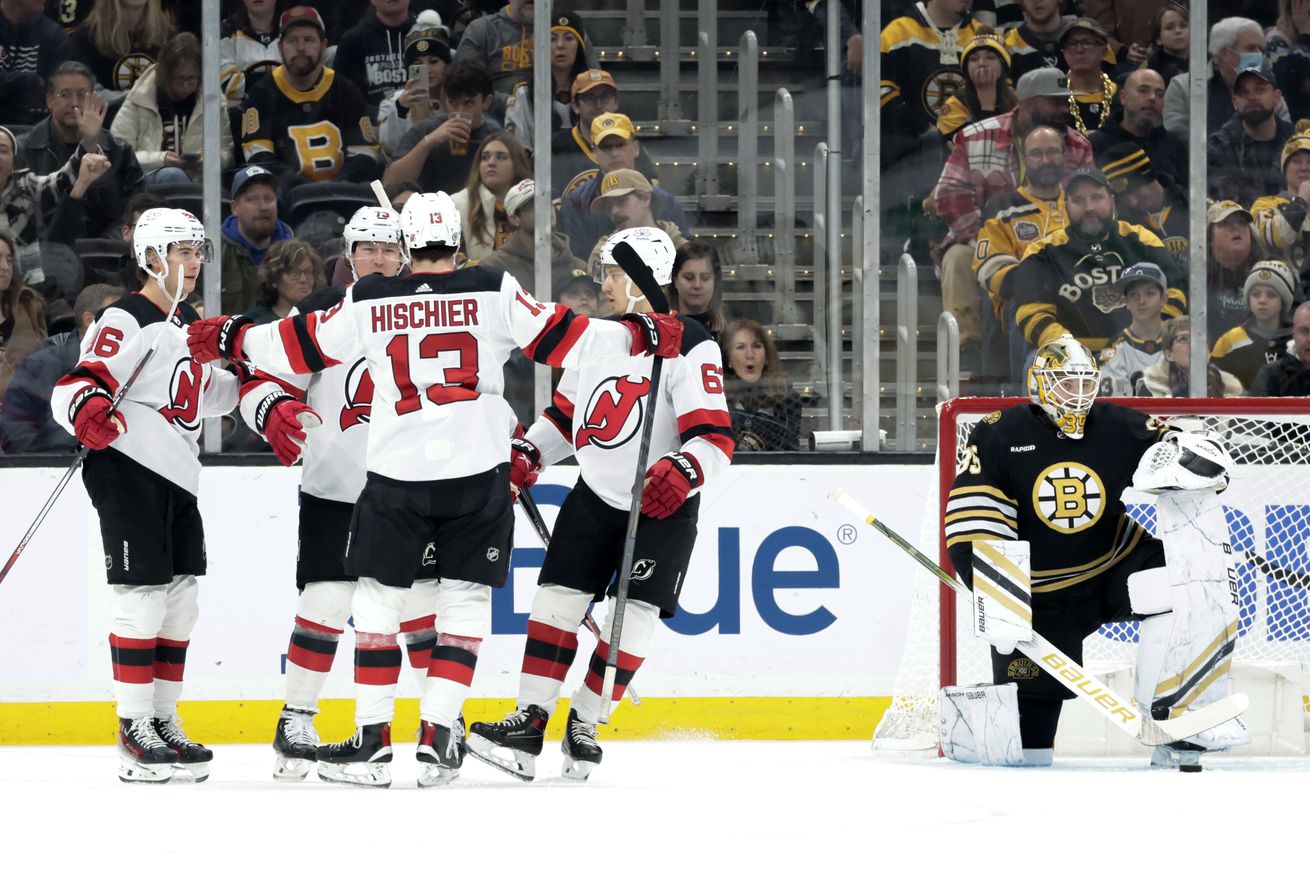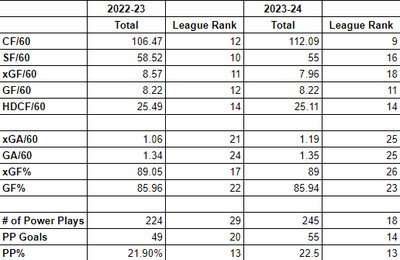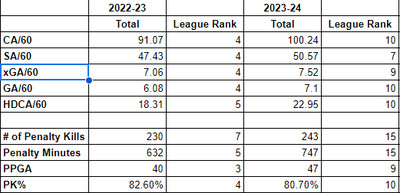
Continuing our week long season preview, today we look at how the additions and subtractions since last season can hopefully improve the New Jersey Devils’ special teams.
Our season preview continues today with a look at the special teams of the New Jersey Devils. While it’s fair to say that the Devils power play and penalty kill weren’t always glowing successes last season, the numbers might surprise some in terms of how well the team actually did in those areas. At the same time, when compared to how the team did in 2023-23, there is room for improvement back to where the team has been.
The back end has some new personnel to hopefully bolster the penalty kill, but the power play didn’t really add anyone of consequence. Today, we dive into the numbers of the past two seasons, while also examining some other narratives around the club’s special teams and forecasting what we hope to see this season.
The Power Play
The Devils are moving on to their fourth different coach in charge of the power play in the past four seasons, and hopefully this will be for the best, as the team’s PP has been firmly middle of the pack. Looking at the stats below, we can see the differences from the team’s power play over the last pair of seasons. Stats below come from Natural Stat Trick, and they do lead me to one area to be alarmed about:

Stats courtesy of Natural Stat Trick
Said area I’m alarmed about that needs to be addressed is the middle portion of the above chart, which all basically amount to the Devils giving up a lot of shorthanded chances for the opposition; the Devils were bottom third of the league last season in terms of opposing chances, expected goals for and actual goals for. If the team wants the power play to be lifted from the middle of the pack and turned into a strength, not only do they have to up their offensive efficiency, but they also need to ensure the puck isn’t moving in the wrong direction.
I’m not going to put all of the scoring weight on one unit, but if the Devils insist on loading up PP1 with Jack Hughes (3:48 per game played last season), Nico Hischier (3:26/GP), Jesper Bratt (3:21/GP), Timo Meier (2:22/GP) and Dougie Hamilton (1:41/GP) or Luke Hughes (3:27/GP but currently injured), then they need to find a way to consistently score. Maybe having new members of the coaching staff fixes that, but if it doesn’t, this might be the season that the Devils begin to look at shifting players around and having more balance within their units. Once Luke is healthy, the team will wind up having to place one of him or Hamilton on that second unit anyway, so why not supply them with at least one of the others from the group that is currently the first unit?
Depending upon deployment, the Devils have options for who else will be playing on the power play. The second unit will most likely feature Dawson Mercer and Tomas Tatar along with Simon Nemec, at least again until Hughes is healthy. The other slots could be rotated between Ondrej Palat, Erik Haula, Stefan Noesen and Paul Cotter. If the fully loaded PP1 isn’t clicking at a high rate, perhaps Noesen or Cotter gets a chance to be a net front screen/rebound player. The Devils also might play two defenders on this pairing when healthy due to their offensive potential.
I will say I don’t think the Devils have as much as they did last season in terms of dangerous personnel for the power play. Looking at last season’s preview and the units the team had out for the “dress rehearsal” game, I don’t see the same depth. The hope this season might have to be in one unit getting majority of the minutes on each man advantage, or the coaches will have to try to figure out early who their featured trios are (such as Hamilton/Jack/Bratt and Nemec/Hischier/Meier) and find supporting castmates who best fit those groups. Not to say they need to group them off by trios either, but outside of maybe Mercer, who else from the list of available personnel is above the level of “supporting player” on a power play?
I think 2024-25’s New Jersey Devils power play will feature an adjustment period at the start. Between some new pieces, new coaching, and waiting for injured players to return, there’s going to be some growing pains. If the team can find the necessary cohesion and a system that works best for the players, then the power play can hopefully rise from average to at least a Top 10 unit.
The Penalty Kill
The penalty kill is actually where the Devils saw more of a regression last season, and yet overall the group was still pretty successful. Allowing a goal on roughly 1 of every 5 opposing power plays isn’t great, but when the percentage is 10th best in the league and you look at the numbers overall, there isn’t a need to make full scale changes:

Stats courtesy of Natural Stat Trick
Some of what the aspects of the kill that the team could have controlled better were allowing more shots, more chances, and more high danger chances. This resulted in 7 more goals across the season and a 1.9% dip in the group’s killing percentage. It certainly wasn’t as if the team bottomed out, but some of the losses on defense were felt in this area, resulting in what was a Top 5 penalty kill the year prior just remaining in the league’s Top 10. The penalty killing was good overall last season, but there’s room to improve here too.
Additions to the defense will more than likely have a positive impact on the Devils this season. The team’s main four penalty killing defensemen in order of ice time last season were John Marino (2:58 per game played), Brendan Smith (2:48/GP), Jonas Siegenthaler (1:51/GP) and Kevin Bahl (1:48/GP) and right away you might notice three of those four are no longer with the team. While Santeri Hatakka averaged 1:42 per game when he played, that was only across 12 contests. The only other regular was Simon Nemec, who in his 60 games, spent on average 51 seconds of each on the PK.
While Siegenthaler is penciled in for a spot, and Nemec will probably be in the mix (particularly at the start of the season), the other spots will all be filled by new additions. Brenden Dillon and Brett Pesce are going to be instrumental here, while Jonathan Kovacevic will also be leaned on when he’s in the lineup. With defenders that are more mobile, better at blocking passes, and with (hopefully) better play in the crease, there will be less pucks going in when the Devils are short.
The forwards? I expect a lot of the same from the Devils, as Erik Haula (2:00/GP), Dawson Mercer (1:45/GP), Nico Hischier (1:22/GP), Curtis Lazar (1:06/GP), and Jesper Bratt (1:00/GP) are all still integral parts of the team. Add Paul Cotter to absorb the minutes of Tomas Nosek, who left in free agency, and the forwards also have a small facelift as well. Not much will change, or maybe even needs to change here, as long as the forwards support and rotate with the defense and help get the puck out of the zone. Let’s hope they do it at a rate more similar to 2022-23 and get back to being closer to a Top 5 PK.
Closing Thoughts and Your Take
Offseason adjustments to personnel, both on ice (defense) and off ice (coaching) could result in differing performance of the Devils’ special teams in 2024-25. While there is no guarantee that either group gets better or worse, the Devils at the very least did not stay stagnant and attempted to address some of the areas not named goaltending that did not perform up to expectations in 2023-24. I do foresee an adjustment period as I mentioned above, particularly due to the shortened camp/preseason and early start of the regular season. Once the team gets into a rhythm, however, the club’s special teams could be a driving force towards them having a successful 2024-25 season.
How do you think things will shake out for the Devils’ special teams this year; will both unit bounce back and be pillars of strength for the team? Will the power play still struggle at bleeding chances for the opposition? Will the changes on defense return the Devils’ PK to Top 5 in the league? Leave any and all comments below and thanks as always for reading!